

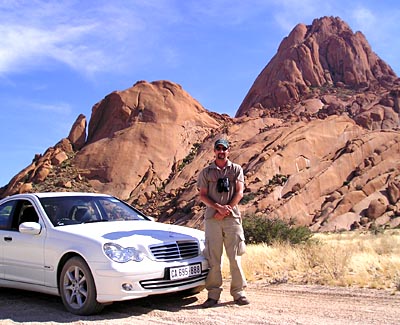 |
 |
|
a trip report by
|
Don Roberson & Rita Carratello |
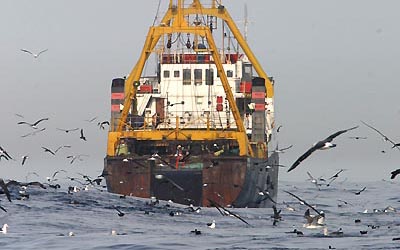 |
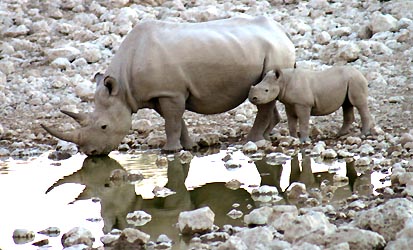 |
|
|
Top & then clockwise: Gemsbok at dusk on a Kalahari ridge; our guide Richard White and his usual tour vehicle (a Mercedes Benz), at Spitzkoppe in nw Namibia; male White-quilled Bustard in Etosha Nat'l Park, Namibia; albatrosses and other pelagics following trawler off Cape Town; mother & calf Black Rhinoceros at Okaukuejo waterhole, Etosha Nat'l Park |
|
My highest priorities were to observe two new Africa bird families, so we structured the trip to do so, plus to emphasize endemic birds, focus on a list of wanted mammals, and allow time for extensive photography [Rita did digital video while Don used his new digital Canon camera]. In western South Africa we used Adam's car (a small Honda) but when the Kalahari dust proved too much for it, Rockjumper booked us a new rental vehicle in Windhoek, Namibia. This turned out to be — again, quite by accident — an exceptionally comfortable Mercedes Benz. Suddenly we got a lot more respect everywhere we went! The trip was a fabulous success from the perspective of objectives obtained. Here is a short set of photo highlights: |
 |
Chaetops frenatus This represents a much-wanted new bird family (see also its family page). Although traditionally placed near thrushes, the two rockjumpers of South Africa actually evolved at the base of the passerine tree of life, closest to Picathartes (Rockfowl), and very far removed from thrushes. They separated from the rockfowl ~31 million years ago (Beresford et al. 2005). They are completely unique, not to mention elusive and spectacular. |
|
Promerops cafer The other planned new family for the trip; there are two species in South Africa, and this one is endemic around the Cape. They rely heavily on flowering Protea plants. The sugarbird proved to be reasonably widespread within range and habitat, and we encountered small numbers daily during the first week of the trip. Recent biochemical evidence (Beresford et al. 2005) suggests that the Spot-throat (Modulatrix) and Dapple-throat (Arcanator) of eastern Tanzania may be members of the sugarbird family [Promeropidae] |
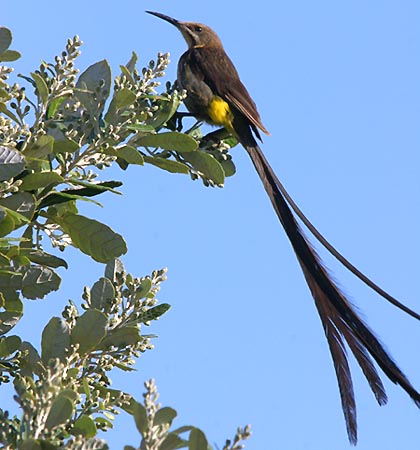 |
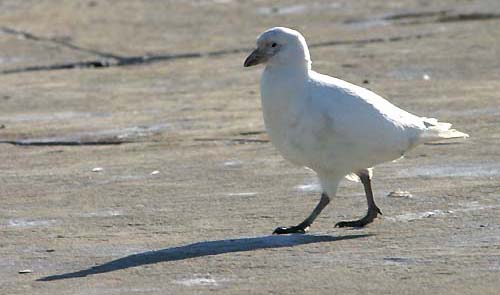 Snowy
Sheathbill Snowy
Sheathbill
Chionas alba A totally unexpected vagrant — representing yet another new family — were two sheathbills that had just appeared in Cape Town harbor. Through the help of Richard White's connections and local Trevor Hardaker, we connected with local birder Eugene Fourie who had first found one bird on 24 June, and two on 27 June. We missed them our first try on 30 June but with lots of non-public access provided by Eugene on 2 July, saw both birds at a distance and this one close up. It was very skittish and flew across the harbor just after this shot. This is the nesting species around the Antarctic Peninsula and Falklands but the population disperses from April-June, when vagrants reach coastal South America. The few South African birds may be ship-assisted but the records are limited to June-July, consistent with the dispersal pattern. There is no evidence this bird was captured or transported against its will, and it could (and did) fly vigorously and was very wary. |
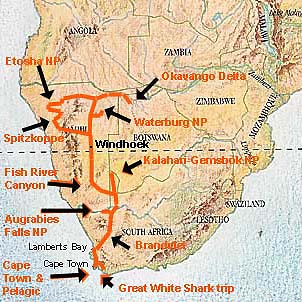 After
a week around Cape Town and the coast, we saw much of the spectacular interior
of southwestern Africa on a 6000 km driving tour outlined on the map (right).
A very general itinerary follows; more detailed daily logs appear on a
separate page (see links below): After
a week around Cape Town and the coast, we saw much of the spectacular interior
of southwestern Africa on a 6000 km driving tour outlined on the map (right).
A very general itinerary follows; more detailed daily logs appear on a
separate page (see links below):
Days 1-5 Cape Town & vicinity, including a pelagic trip and a Great White Shark tripHere are just a few more highlights: |

MAJOR HIGHLIGHTS
Beyond the three new families (actually five new families for Rita who also added Penguins and Penduline-Tits), and the fine boat trip,
High points included
|
MAJOR DIPS
Every trip has some dips. No one sees everything possible in a single
trip, excepting visits of small islands with a limited set of a dozen or
so endemics. Here — where the possibilities ranged into hundreds of species
— the only serious 'dips' or disappointments were:
|
 |
Because this was a 'private' tour, we could structure it as we liked,
and we allowed lots of time for photography. I'm pleased to say we did
very well in finding birds and mammals of interest, but obtaining photos
or video of them was almost as important. You'll find many examples of
photography from the trip on these pages. Here is one of my favorites:
Swallow-tailed Bee-eater pair
|
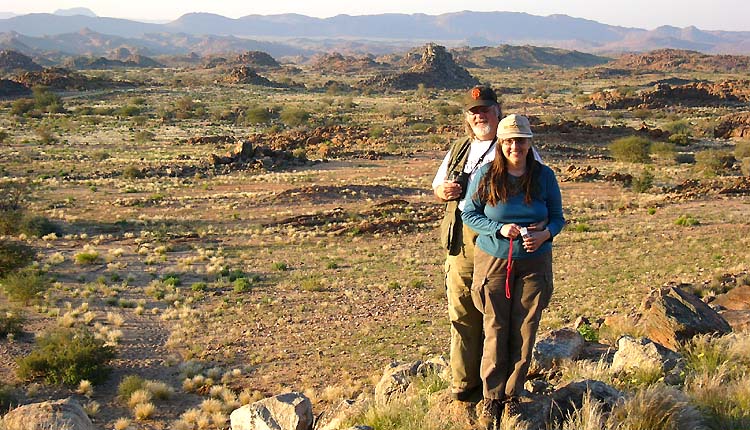
|
This trip report continues with a daily log — including a photo-heavy overview of the major regions visited — and annotated trip lists. Follow the links below: |
|
|
|
|
|
|
|
|
|
|
|
|
Literature cited:
Beresford, P., F.K. Barker, P.G. Ryan, and T.M. Crowe. 2005. African endemics span the tree of songbirds (Passeri): molecular systematics of several evolutionary 'enigmas'. Proc. R. Soc. B 272: 849-858.TOP
GO TO LIST OF BIRD FAMILIES OF THE WORLD